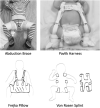Principles of Bracing in the Early Management of Developmental Dysplasia of the Hip
- PMID: 34785821
- PMCID: PMC8582338
- DOI: 10.1007/s43465-021-00525-z
Principles of Bracing in the Early Management of Developmental Dysplasia of the Hip
Abstract
Bracing is considered a gold standard in treating Developmental Dysplasia of the Hip (DDH) in infants under 6 months of age with reducible hips. A variety of braces are available that work on similar principles of limiting hip adduction and extension. This paper summarises the current evidence regarding bracing in DDH. Most of the literature pertains to the Pavlik harness (PH) and there are few studies for other brace types. Bracing eliminates dislocating forces from the hamstrings, the block to reduction of the psoas and improves the muscle line of pull to stabilise the hip joint. Recent studies have shown no benefit in bracing for stable dysplasia. The rates of PH treatment failure in Ortolani-positive hips have been reported to be high. Barlow positive hips have lower Graf grades and are more amenable to PH treatment. There is consensus that the earlier the diagnosis of DDH and initiation of PH treatment, the better the outcome. Failure rates due to unsuccessful reduction and AVN are higher with treatment initiated after age 4-6 months. Studies have shown no benefits of staged weaning of braces. While there is no maximum time in brace, current consensus suggests a minimum of 6 weeks. The key to successful bracing lies in education and communication with the family.
Keywords: Abduction Brace; Brace; DDH; Pavlik Harness.
© Crown 2021.
Conflict of interest statement
Conflict of interestOn behalf of all authors, the corresponding author states that there is no conflict of interest.
Figures





References
-
- Ramsey PL, Lasser S, MacEwen GD. Congenital dislocation of the hip. Use of the Pavlik harness in the child during the first six months of life. The Journal of Bone & Joint Surgery. 1976;58(7):1000–1004. - PubMed
-
- Graf R. Classification of hip joint dysplasia by means of sonography. Archives of Orthopaedic and Trauma Surgery. 1984;102:248–255. - PubMed
-
- Graf R. Hip sonography: 20 years experience and results. Hip International. 2007;17(SUPPL. 5):8–14. - PubMed
Publication types
LinkOut - more resources
Full Text Sources
Research Materials
